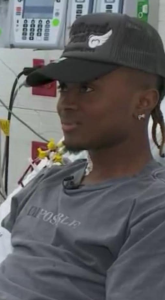Patient May Become First Person in Louisiana to Be Cured of Sickle Cell Disease
Medical history may soon be written in Louisiana, where a patient living with sickle cell disease is on the verge of becoming the state’s first documented case of a full cure. For decades, sickle cell has been a devastating illness—one that has claimed countless lives, left families in anguish, and caused patients to endure cycles of pain and hospitalizations. Now, thanks to groundbreaking medical advancements and the courage of one patient, hope is breaking through.
Understanding Sickle Cell Disease
Sickle cell disease (SCD) is a genetic blood disorder that affects the shape of red blood cells. Instead of being round and flexible like healthy cells, sickled cells are crescent-shaped and rigid. These abnormal cells can clump together, blocking blood flow and oxygen throughout the body. The consequences are severe: chronic fatigue, excruciating pain episodes known as “crises,” frequent infections, organ damage, and reduced life expectancy.
In the United States, sickle cell disproportionately affects African Americans and other communities of color. About 100,000 Americans live with SCD, and while treatments exist to manage symptoms, a true cure has been elusive—until recently.
A Breakthrough in Louisiana
The patient, whose name is being withheld for privacy, is undergoing an advanced form of therapy at a Louisiana medical center. Doctors there are pioneering the use of gene therapy and stem cell transplantation—two approaches that, when combined, have the potential to completely eradicate sickle cell from the patient’s system.
The procedure works by replacing or correcting the defective gene responsible for sickling. In some cases, doctors use the patient’s own stem cells, modified in a lab, to produce healthy red blood cells. In others, a donor stem cell transplant is used. Either way, the ultimate goal is the same: to allow the body to create normal, round blood cells that can flow freely and provide adequate oxygen.
If successful, this patient will not only be pain-free for the first time in their life but will also no longer carry the disease at all.
Why This Matters for Louisiana
Louisiana has one of the highest rates of sickle cell disease in the country. Generations of families here have suffered in silence, navigating a condition that is often misunderstood and underfunded in research.
For patients in Louisiana, healthcare disparities have historically created barriers to care. Many sickle cell warriors struggle with access to specialized treatment, leaving them reliant on emergency rooms during pain crises. The possibility that one of their own may be cured sends shockwaves of hope through the community.
Local advocacy groups already see this case as a turning point. “This is not just one patient’s story,” one advocate explained. “This represents the hope of thousands of families who have prayed for a cure their entire lives.”
The Patient’s Journey
For this Louisiana patient, the road has been long and grueling. Since childhood, hospital stays were a regular part of life. Family members recall sleepless nights filled with cries of pain and the helplessness of knowing little could be done beyond pain management and transfusions.
Yet through perseverance and a relentless medical team, the patient was identified as a candidate for the new therapy. Under strict protocols, the patient underwent conditioning treatments to prepare the body, followed by the transplant itself. Now, with careful monitoring, doctors are optimistic: early blood tests show that the patient’s body is producing normal red blood cells.
For the first time, there is light at the end of what seemed like a lifelong tunnel.
The Broader Implications
If confirmed, this cure could be revolutionary—not just in Louisiana but nationwide. It would mark another step in proving that sickle cell disease, long considered an uncurable condition, can in fact be defeated.
What makes this breakthrough especially significant is that sickle cell research has historically lagged behind. While diseases like cystic fibrosis or certain cancers have received heavy research funding, sickle cell has often been overlooked despite the large number of people it affects. Advocates argue that systemic inequalities played a role in this neglect.
A successful cure in Louisiana could galvanize new funding, more widespread clinical trials, and a broader push for accessibility. The hope is that this treatment will move beyond experimental stages into standard care, available for all who need it—not just those in specialized programs.
The Risks and Challenges
While optimism is high, doctors remain cautious. Gene therapy and stem cell transplants carry risks, including infection, rejection, or complications from the chemotherapy used in preparation. Not every patient is eligible, and not all transplants succeed.
Cost is another challenge. Gene therapy treatments can reach millions of dollars per patient, raising questions about insurance coverage and equitable access. If only the wealthy or well-connected can be cured, the breakthrough will leave many behind.
Still, even with these obstacles, the potential is undeniable. Every successful cure builds momentum, paving the way for safer, more affordable, and more widely available treatments.
A Community Waiting in Hope
The announcement has already sparked conversations in churches, community centers, and family homes across Louisiana. For many families who have buried children far too soon or watched loved ones endure decades of suffering, this single case feels personal.
Support groups are buzzing with cautious optimism. “We’ve heard promises before,” one mother of a sickle cell patient shared. “But this time feels different. If this young person makes it through cured, it will mean my child could too.”
Looking Ahead
The next few months will be crucial. Doctors will continue to monitor the patient’s blood levels, immune response, and overall health. If all continues smoothly, the patient could be declared cured within the year.
Should that happen, Louisiana will be able to say it is home to the first cured sickle cell patient in its history—a milestone that could change the trajectory of healthcare for generations.
Final Thoughts
Sickle cell disease has long been a story of pain, perseverance, and inequality. For countless families, it has meant watching loved ones suffer without relief, knowing there was no cure in sight. But now, in Louisiana, hope has a new face. One patient stands on the threshold of history, carrying not just their own dreams of healing but the prayers of thousands who share the same struggle.
If successful, this case will not only mark a scientific triumph—it will mark a human one. It will prove that even the most stubborn diseases can be overcome when science, determination, and compassion unite. For Louisiana, for America, and for the world, the possibility of curing sickle cell is no longer just a dream. It is, at last, becoming a reality.


